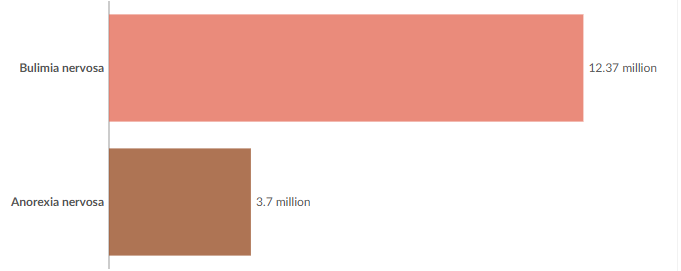Leveraging Artificial Intelligence to Combat the Rising Tide of Bulimia
By Panthira Poositranusorn, GRC 2024 Global Essay Competition Top 30
With a 3.9% mortality rate and a death rate of 1.49, bulimia nervosa stands as one of the deadliest psychiatric disorders (Quadflieg and Fichter 2016). Despite its life-threatening nature, fewer than half of those with bulimia nervosa have ever sought treatment for their eating disorder (ED) (Pike 2024). Given the disorder’s complexity and the lack of awareness surrounding it, the widespread integration of artificial intelligence (AI) has the potential to revolutionise its treatments by providing personalised support, early detection, and virtual therapy options.
Bulimia nervosa is the repeated cycle of bingeing (uncontrolled episodes of overeating) and purging (vomiting, excessive exercising, or abuse of laxatives or diuretics). The global prevalence of EDs increased from 3.4% to 7.8% between 2000 and 2018, with bulimia being particularly prominent among adolescents, highlighting a worrying trend that affects millions of young people (Rehman 2020). The physical damage caused by bulimia is severe, ranging from the heart to the digestive system. Mentally, the disorder also takes a toll: among adolescents with bulimia, 49% meet criteria for major depression and 66% meet criteria for an anxiety disorder (Linardon 2020).
Many individuals with bulimia are adept at concealing their condition, often hiding it behind smiles and normal outward behaviours. Eventually, this secrecy will lead to detrimental electrolyte imbalances, heart complications, and oesophageal tears. Emotional barriers, such as denial and self-stigma, along with systematic barriers, such as limited access to care, prevent many adolescents from seeking help.
Delays in treatment may significantly increase the risk of adverse outcomes, including heightened psychological distress and progression of the disorder. Conversely, shorter duration of untreated eating disorder strongly predicts higher remission rates, emphasising the importance of early detection and intervention (Andrés-Pepiñá, et al. 2019) .
In recent years, the widespread adoption of AI, especially machine learning and deep learning, has shown potential in both diagnosis and treatment strategies for EDs. Machine learning efficiently analyses diverse datasets, including patient demographics and neuroimaging data, to identify patterns indicative of ED (Cearns, Hahn and Baune 2019); this allows prompt and tailored interventions to meet specific patient needs (Wang 2021).
Deep learning techniques, particularly convolutional neural networks (CNNs), play a vital role in modelling complex relationships within ED datasets. They can process various inputs, including images, to capture subtle features relevant to ED pathology (Khelifi and Mignotte 2020). For instance, CNNs trained on neuroimaging data can detect structural and functional idiosyncrasies in brain regions implicated in EDs, providing insights into neurobiological mechanisms underlying disordered eating behaviours (Monaco, et al. 2024).
Social media forums that encourage ED behaviours have become a growing concern in recent years with their mass promotion of “pro-bulimic” lifestyles and “thinspiration” (Figure 2). Though this conduct is often perceived as encouraging unhealthy, disordered manner of living, and an obsession with achieving thinness, it also acts as an outlet for individuals to disclose struggles without feeling stigmatised, and offers a supportive network that is not achievable offline (Fitzsimmons‐Craft, et al. 2019). Natural Language Processing (NLP) has emerged as a powerful tool for analysing textual data from various sources. By inspecting linguistic patterns and semantic cues, NLP models can identify high-risk individuals, assess treatment adherence, and accurately predict relapse probabilities. Studies have shown that NLP can effectively detect signs of EDs in social media posts, providing valuable insights into symptomatology and treatment outcomes (Fitzsimmons‐Craft, et al. 2019).
In addition, the increasing use of AI-powered chatbots, such as Wysa, provides users with cognitive behavioural therapy techniques and emotional support through conversational interfaces (Wysa 2024). As well as being cost-effective, AI chatbots are reliable and approachable, providing immediate support without the need for appointments or travel. Despite AI’s inability to fully replicate human empathy and nuance, research suggests that Wysa users experienced a positive reduction in depressive symptoms (Haque and Rubya 2022). These findings highlight the potential of AI chatbots not only as supplementary tools but also as viable alternatives for those who may not engage with traditional forms of therapy.
A notable development of AI for bulimia treatment was made by KU Leuven and the University of California, Berkeley, which created a model for predicting binge eating and drinking. The algorithm analyses emotional factors, sending users a notification, alerting them of upcoming risks (KU Leuven 2024).
Bulimia nervosa remains a silent crisis, with life-threatening consequences for those affected. Despite the barriers of stigma, denial, and systemic gaps in care, innovative solutions offer new hope. AI’s diversity in its functions, from machine learning to cognitive behavioural therapy, positions it as a prominent and novel innovation in combating fatal psychiatric illnesses like bulimia. Through personalised interventions, psychoanalysis could be profoundly transformed for adolescents and beyond. By leveraging AI and fostering a supportive environment, we can move closer to a world where bulimia is no longer a hidden battle but a challenge we face together with compassion and innovation.
Figure 1: Anorexia or bulimia nervosa estimated cases, World, 2021
Figure 2: Pinterest Boards Encourage Eating Disorders

Bibliography
Andrés-Pepiñá, Susana, Sonia Romero, Maria Teresa plana, Itziar Flamarique, Roger Borràs, Laia Julià, Miguel Gárriz, and Josefina Castro-Fornieles. 2019. "Long-term outcome and psychiatric comorbidity of adolescent-onset anorexia nervosa." Clinical Child Psychology and Psychiatry 33-44.
Cearns, Micah, Tim Hahn, and Bernhard T. Baune. 2019. "Recommendations and future directions for supervised machine learning in psychiatry." Translational Psychiatry 9(1):271.
Fitzsimmons‐Craft, Ellen E., Micah Goodman, Melissa Krauss, Sanmay Das, and Patricia Cavazos‐Rehg. 2019. "Automatic detection of eating disorder‐related social media posts that could benefit from a mental health intervention." International Journal of Eating Disorders 52 (10): 1150-1156.
Haque, Romael, and Sabirat Rubya. 2022. "An Overview of Chatbot Based Mobile Mental Health Applica-tions: Insights from App Description and User Reviews (Preprint)." JMIR mHealth and uHealth.
Khelifi, Lazhar, and Max Mignotte. 2020. "Deep Learning for Change Detection in Remote Sensing Images: Comprehensive Review and Meta-Analysis." IEEE Access 8: 126385-126400. doi:10.1109/access.2020.3008036.
KU Leuven. 2024. Artificial Intelligence can help predict binge eating and binge drinking in everyday life. 7 10. https://nieuws.kuleuven.be/en/content/2024/artificial-intelligence-can-help-predict-binge-eating-and-binge-drinking-in-everyday-life.
Linardon, Jake. 2020. Bulimia Nervosa Statistics: Latest Facts & Research on Bulimia [2020]. 2 1. https://breakbingeeating.com/bulimia-nervosa-statistics/.
Monaco, Francesco, Annarita Vignapiano, Martina Piacente, Claudio Pagano, Carlo Mancuso, Luca Steardo, Alessandra Marenna, et al. 2024. "An advanced Artificial Intelligence platform for a personalised treatment of Eating Disorders." Frontiers in Psychiatry.
Pike, Ellie. 2024. Eating Disorder Statistics | Anorexia, Bulimia, Binge Eating & ARFID. 2 14. https://www.eatingrecoverycenter.com/resources/eating-disorder-statistics.
Quadflieg, Norbert, and Manfred Maximilian Fichter. 2016. "Mortality in eating disorders - results of a large prospective clinical longitudinal study." The International journal of eating disorders 391-401.
Rehman, Anis. 2020. Eating disorder statistics in the U.S. in 2020. 6 3. https://www.singlecare.com/blog/news/eating-disorder-statistics/.
Wang, Shirley B. 2021. "Machine learning to advance the prediction, prevention and treatment of eating disorders." European Eating Disorders Review 683-691.
Wysa. 2024. AI CBT - Wysa - Everyday Mental Health. https://www.wysa.com/ai-cbt.



